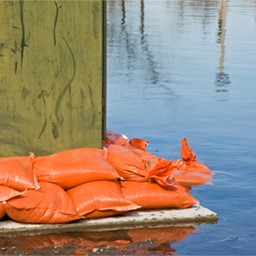Issued: April 2016
Flooding in Scotland has the potential to affect one in 13 businesses and one in 22 homes. The central belt, traditionally Scotland’s industrial and residential heart, is at the greatest risk.
New plans to manage risk
The Flood Risk Management (Scotland) Act 2009 changed Scotland’s approach to flood risk.
The National Flood Risk Assessment of the impact of flooding across Scotland followed, and produced flood maps identifying 243 Potentially Vulnerable Areas (PVAs) where the risk of flooding is high and where development may be restricted or require an in-depth Flood Risk Assessment (FRA). Scotland is divided into 14 local plan districts, each with a specific Flood Risk Management Strategy setting out actions to tackle flood risk.
The Scottish Environment Protection Agency (SEPA), in partnership with other organisations, are currently developing the first Flood Risk Management Strategies and Local Flood Risk Management Plans. The intention is to focus action in the areas with the greatest risk of flooding and where the benefits of intervention can be realised.
The natural approach to flood management
SEPA also stress the need for combating flood risk with natural flood measures, such as planting along river margins and banks, as well as traditional flood defences (The Natural Flood Management handbook, SEPA, January 2016).
Natural flood measures cost less to implement, so they have the potential to reduce costs incurred by defences such as flood walls and embankments.
Do I need a Flood Risk Assessment?
An FRA is required to support the planning application of any site, or parts of any site, that could be at ‘medium to high risk of flooding’ or a ‘1 in 200-year flood’ (a 0.5% annual probability of flooding).
Typically, developments falling into this category will be located on or adjacent to a floodplain, where avoidance of areas at risk of flooding or the discouragement of development is not possible. SEPA classifies developments on their intended use. They range from the Most Vulnerable (eg schools, care homes and uses required to operate during a flood) to Less Vulnerable (eg commercial, agriculture and waste-related developments).
Developments that are Essential Infrastructure (power stations, wind turbines and transportation) and Water compatible (flood defences, parkland and pumping stations) are classified separately.
The size and scope of a FRA will largely depend on which category the development comes under and the degree of risk from flooding on or adjacent to the site.
What will a Flood Risk Assessment tell me?
An FRA analyses a development’s potential flood risks from all possible flooding sources and identifies site-specific measures to reduce the risk.
In brief, an FRA will ensure that you:
- are aware of all potential flood risks
- know if acceptable measures to reduce flood risk can be established
- have considered all possible measures to reduce risk
- can confirm that your development is as safe as possible from flooding
- know if your development meets the requirements of planning policy.
How WHS can help
SEPA recommends that a flood risk specialist has:
- undertaken this type of assessment before
- had work in support of planning applications accepted by SEPA
- used the guidance available on the SEPA website
- local knowledge and experience.
WHS is ahead of the game in terms of our knowledge of the science and our understanding of the rules and engagement with the authorities.
WHS will give you a clear, reasoned and robust flood risk assessment to win approval for your development.
The last word
“It is incumbent upon prospective developers to take flood risk into account before committing themselves to a site or project”. SEPA
You should seek advice on the size and scope of a required FRA from a flood risk specialist at the earliest opportunity.